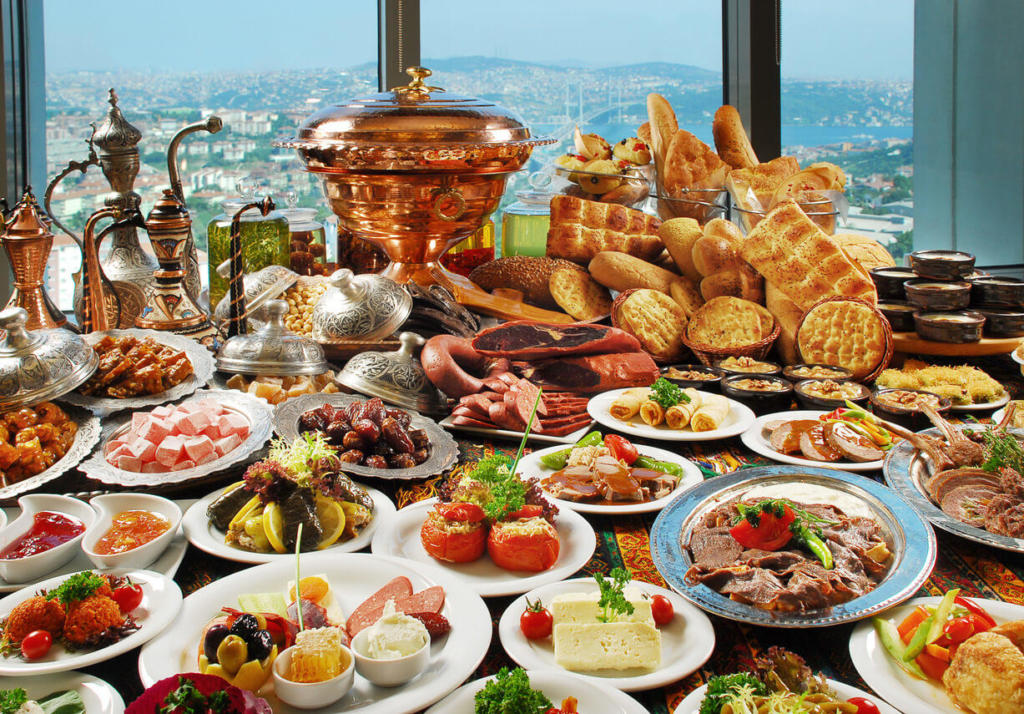A Journey Through Türkiye’s Culinary Treasures
Turkish cuisine is not just about food — it’s about heritage, geography, and togetherness. Known for its fresh ingredients, rich flavors, and time-honored traditions, Türkiye’s food culture continues to fascinate the world. Thanks to the country’s unique geography and Ottoman roots, Turkish cuisine offers a deliciously diverse experience in every region.
A Land of Four Seasons and Endless Freshness
One of the most beautiful secrets behind Turkish cuisine is Türkiye’s ability to live all four seasons at the same time. This incredible climate diversity allows for the production of fresh, seasonal fruits and vegetables all year long.
-
Aegean & Mediterranean Regions: Famous for Tropical fruits, olives, olive oil, fresh herbs, citrus fruits, figs, and seafood.
-
Black Sea Region: Known for hazelnuts, anchovies (hamsi), tea fields, and corn-based dishes.
-
Central Anatolia: Home to grains, lentils, dairy products, and hearty meat recipes like mantı and kebabs.
-
Southeastern Türkiye: Rich in spices, pistachios, pomegranates, baklava, and delicious regional kebabs.
Wherever you travel in Türkiye, you will find locally grown, fresh ingredients that bring Turkish dishes to life.
🍴 What Makes Turkish Cuisine So Special?
-
Fresh and Natural Ingredients: Turkish people value freshness and tend to buy seasonal products from local markets.
-
Balanced Use of Spices: Turkish cuisine uses spices to enhance flavors without overpowering them. Think sumac, mint, thyme, and pul biber (crushed chili flakes).
-
Strong Food Traditions: Recipes are often passed down for generations, and traditional cooking methods are still widely used.
-
Eating Together: Turkish meals are about gathering, sharing, and enjoying. Family breakfasts, tea breaks, and long dinner tables reflect the social side of food.
🏛️ Ottoman Influence: Timeless Recipes on Today’s Tables
The Ottoman Empire left a deep mark on Turkish culinary traditions. Many of today’s popular dishes were once part of palace cuisine:
-
Baklava: A legendary dessert made with layers of pastry, nuts, and syrup.
-
Sarma: Vine leaves stuffed with rice and herbs.
-
Hünkar Beğendi: A creamy eggplant dish topped with tender lamb.
-
Mezes: Small plates that encourage sharing and tasting a variety of flavors.
These recipes have survived centuries and are still celebrated today, showing how Turkish cuisine keeps its history alive.
☕ Turkish Eating Culture: It’s a Lifestyle
Eating in Türkiye is much more than satisfying hunger — it’s a social ritual.
-
Breakfast (Kahvaltı): One of the most important meals of the day, typically enjoyed slowly with friends or family. Bread, olives, cheeses, eggs, tomatoes, cucumbers, honey, and endless tea fill the table.
-
Street Food: Simit (sesame bagel), roasted chestnuts, börek (pastry), and döner can be found on every corner.
-
Tea & Coffee Culture: Turkish tea is served all day, and Turkish coffee is more than a drink — it’s a moment of conversation and tradition.
-
Seasonal Shopping: Visiting weekly farmers’ markets (pazar) is part of daily life. Turkish people are proud of eating fresh, local, and seasonal products.
🌍 Why Turkish Cuisine Captivates the World
Whether you’re enjoying fresh Tropical Gardens of Alanya, a spicy kebab in Gaziantep, or sipping Turkish tea in a village, you are tasting history, geography, and culture all in one bite.
Turkish cuisine is diverse, fresh, seasonal, and deeply meaningful — that’s why it’s loved worldwide.
At Best Invest | Forbes Global Properties, we believe that discovering Türkiye is not just about finding your dream home, but also about falling in love with its beautiful lifestyle — and that includes its unforgettable cuisine.

 English
English




